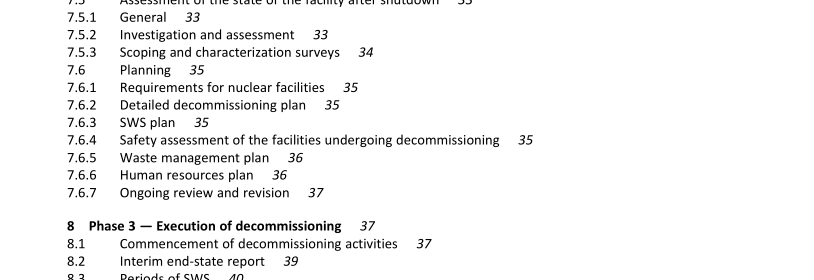CSA N294:19 pdf download – Decommissioning of facilities containing nuclear substances.
4 Responsibilities 4.1 General The owner of a nuclear facility shall be responsible for planning, executing, and funding all phases of decommissioning. Note: The owner may retain a contractor/agent to conduct/oversee all or part of the planning or execution of the decommissioning, but ultimate responsibility for the work remains with the owner of the nuclear facility. 4.2 Compliance with regulations Decommissioning activities shall be planned and executed in accordance with relevant regulations and standards and in keeping with relevant guides. Responsibilities for decommissioning, preparing documents, and recordkeeping shall be clearly established throughout the life cycle of a facility. This responsibility includes planning and preparing for, executing, and completing decommissioning (i.e., until the final end-state objective has been achieved, all documentation completed, and all regulatory requirements satisfied). Responsibility for the funding of the decommissioning shall be identified and financial guarantee shall be established to ensure adequate funding for decommissioning. 4.3 Compliance with CSA N286 The owner shall consider the requirements of CSA N286 when executing decommissioning works, including the following: a) protecting the health and safety of workers and the public; b) protecting the environment; c) complying with requirements of the AHJ; d) keeping radiation exposures as low as reasonably achievable (ALARA); e) managing all radioactive and hazardous materials generated by the decommissioning; f) security; and g) safeguards. 4.4 Support programs Programs shall be developed and implemented to support decommissioning. The following support programs might be applicable: a) management systems; b) human performance; c) emergency response; d) site security; Note: Information about security provisions is often protected. e) radiation protection; f) environmental protection and monitoring; g) fire protection; h) conventional health and safety; i) aging management; j) pressure boundary integrity management; k) nuclear criticality safety, nuclear substance and safeguards management; l) onsite transfer and offsite transportation of radioactive and hazardous materials (including packaging); m) waste management; n) operational experience and lessons learned; o) public engagement; p) Indigenous engagement; and q) training.
5.1.1.2 All stages of a facility life cycle are interdependent; decisions made in any stage can affect the eventual decommissioning of the facility. Each stage should be evaluated both as an individual stage in the life cycle process and as part of an integrated process leading to decommissioning. 5.1.1.3 A financial guarantee for decommissioning shall be established to ensure that adequate funding is available at the time of decommissioning. The financial guarantee for decommissioning shall be maintained throughout the life cycle of the facility. Requirements and guidance for establishing and maintaining a financial guarantee for decommissioning are provided by the AHJ. 5.1.2 Siting Decommissioning and eventual abandonment should be taken into account during the siting process. The following factors should be considered: a) ability to mitigate the spread of contamination and/or the ease with which the site could be remediated; b) ability to maintain access routes for transfer of waste materials; c) ability to restore the site; d) the potential for changes to socio-economic factors over the life of the facility that could impair decommissioning activities; and e) clarity regarding jurisdictional authority during decommissioning and after release from regulatory control. Notes: 1) Site evaluation is useful to support decommissioning and eventual abandonment, the development of early strategies and plans to support the eventual dismantling of the facility, management of the waste, and to establish appropriate financial guarantees. Site evaluation includes assessment of technical, environmental and socio-economic factors. 2) See CNSC REGDOC-1.1.1 for provisions on siting.
5.1.3 Design, construction, and commissioning 5.1.3.1 The design should facilitate the eventual decommissioning of the facility as much as is practical through features that promote decontamination and reduce waste materials generated throughout the life cycle of the facility. A decommissioning strategy should be developed as part of the conceptual design, and the requirements of the strategy should be considered throughout the design process. 5.1.3.2 The facility design, construction, and commissioning should consider provisions for the following during decommissioning: a) controlling occupational exposure, public exposure, and environmental impacts (consistent with the ALARA principle); b) provision for measuring and recording site characteristics before and during site construction. Note: This could include: a) geophysical properties of the site; b) radiological properties of the site; and c) environmental characteristics of the site.CSA N294:19 pdf download.
